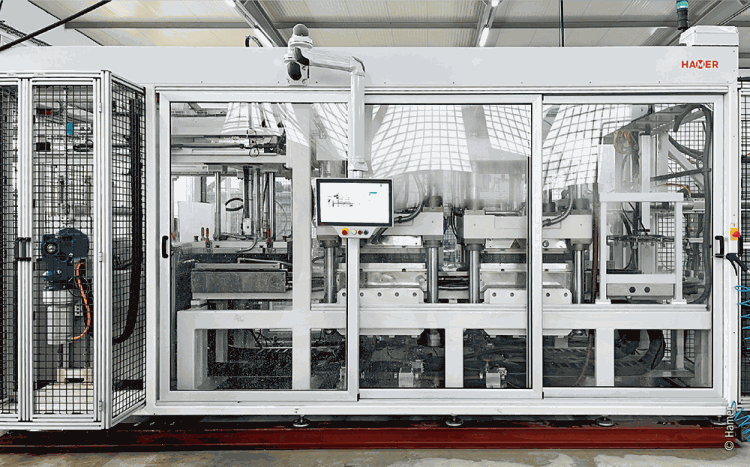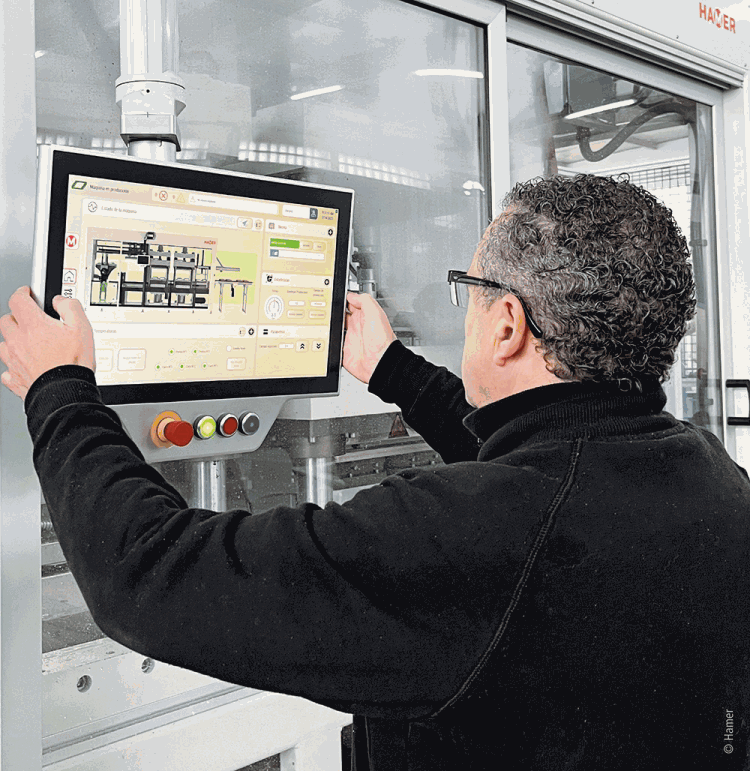
Thermoforming is the most common method for producing trays, dishes and packaging from plastics at low cost; however, many consumers are critical of using plastic as a packaging material. Renewable cellulose is a good alternative, and Hamer has joined forces with Beckhoff to develop a thermoforming machine for water-based cellulose pulp. “Concern for the environment led us to develop a technology for fully recyclable and environmentally-friendly cellulose packaging,” says Joan Ferrer from Hamer’s electrical and software department.

Thermoforming is the most common method for producing trays, dishes and packaging from plastics at low cost; however, many consumers are critical of using plastic as a packaging material. Renewable cellulose is a good alternative, and Hamer has joined forces with Beckhoff to develop a thermoforming machine for water-based cellulose pulp. “Concern for the environment led us to develop a technology for fully recyclable and environmentally-friendly cellulose packaging,” says Joan Ferrer from Hamer’s electrical and software department.
A special feature of the technology is the way the cellulose is dried out by a specific combination of pressure and temperature. This creates dimensionally-stable packaging with clearly defined contours that can be adapted to the dimensions and shape of the item it contains, making it suitable for a wide range of products. “We can now offer our customers a sustainable alternative to conventional plastic packaging,” adds Ferrer.

The process is entirely environmentally friendly, both in the extraction of the raw material and in the way it is subsequently recycled. The packaging material is biodegradable and 100% compostable, and its breathability makes the pulp-based trays suitable for fruit and vegetables. Once laminated, it can even be used for products that need to be packaged under inert gas, and the fact that cellulose does not become electrostatically charged means it can be used to package electronics safely too.
The Hamer HP96 thermoforming machine for pulp also has advantages in terms of technology and productivity. Running four cycles per minute, it outperforms comparable machines on the market by more than double. The machine can process up to 300 g of chemi-thermomechanical pulp (CMTP) per cycle, equating to around 72 kg per hour or 576 kg per shift.
Extensive vertical integration
Boasting a high level of vertical integration, the machine maintains firm control over all processes. “This allows us to enter new markets and develop solutions in line with current requirements,” says Ferrer. The latest evidence of this can be found in wet fibre thermoforming, which Hamer has developed together with Beckhoff.
Wet fibre thermoforming for sustainable packaging
The process starts with preparing the fibres, which involves mixing the basic materials with water to achieve the required consistency. A vacuum absorption process then transports the cellulose pulp from the main tank into the thermoforming machine. Here high-quality 3D-moulded products are created in the thermoforming mould through sophisticated control of the temperature, pressure, pressing time, vacuum and hot drying. The result of this process is packaging with a high level of mechanical strength, along with an ideal surface finish and shape. Any remaining production materials flow back into the production cycle via closed conveyor and water circuits to cut down on material consumption and disposal costs.

The project was a real challenge in terms of motion control and the real-time control of the energy consumption of the drying and forming stations. The typical power consumption of an HP96 is around 140 kWh. EL3443 EtherCAT power measurement terminals are used in conjunction with high-precision SCT3215 and SCT1111 ring-type current transformers to record and control the energy consumption in real time. “By looking at the energy and power consumption, we can very easily check whether everything is working properly and how energy consumption behaves under different working conditions,” explains Ferrer.
The anodised housing and high IP69K protection rating of the servomotors in the AM8700 series offer ideal protection against the large amounts of steam and water that are produced during the process. The One Cable Technology (OCT) of the servomotors also cuts down on wiring work.
Other key elements for the development manager include the IP65-protected CP3916 control panel and TwinCAT HMI. “Both of these allow intuitive control of all processes performed with the equipment, while also increasing the efficiency and safety of the thermoforming machine,” notes Ferrer. The visualisation is based entirely on HTML5 and is therefore platform-independent, making Hamer’s HMI future-proof since the machines can be operated from any PC or other mobile device. TwinCAT makes it possible to extract machine data in a variety of ways. Object-oriented programming makes it easier to reuse code, and the Git version management software is also highly beneficial.
This project is an important milestone for Hamer, and demonstrates how innovation and collaboration can lead to unique and effective solutions. “I am confident that our collaboration will produce more innovative and efficient packaging solutions going forward,” says Ferrer. “In fact, we have already identified the Beckhoff technology that we have our sights set on next, namely TwinCAT Vision, TwinCAT Analytics and TwinCAT Cloud Engineering.”
| Tel: | +27 11 795 2898 |
| Email: | [email protected] |
| www: | www.beckhoff.com |
| Articles: | More information and articles about Beckhoff Automation |
© Technews Publishing (Pty) Ltd | All Rights Reserved